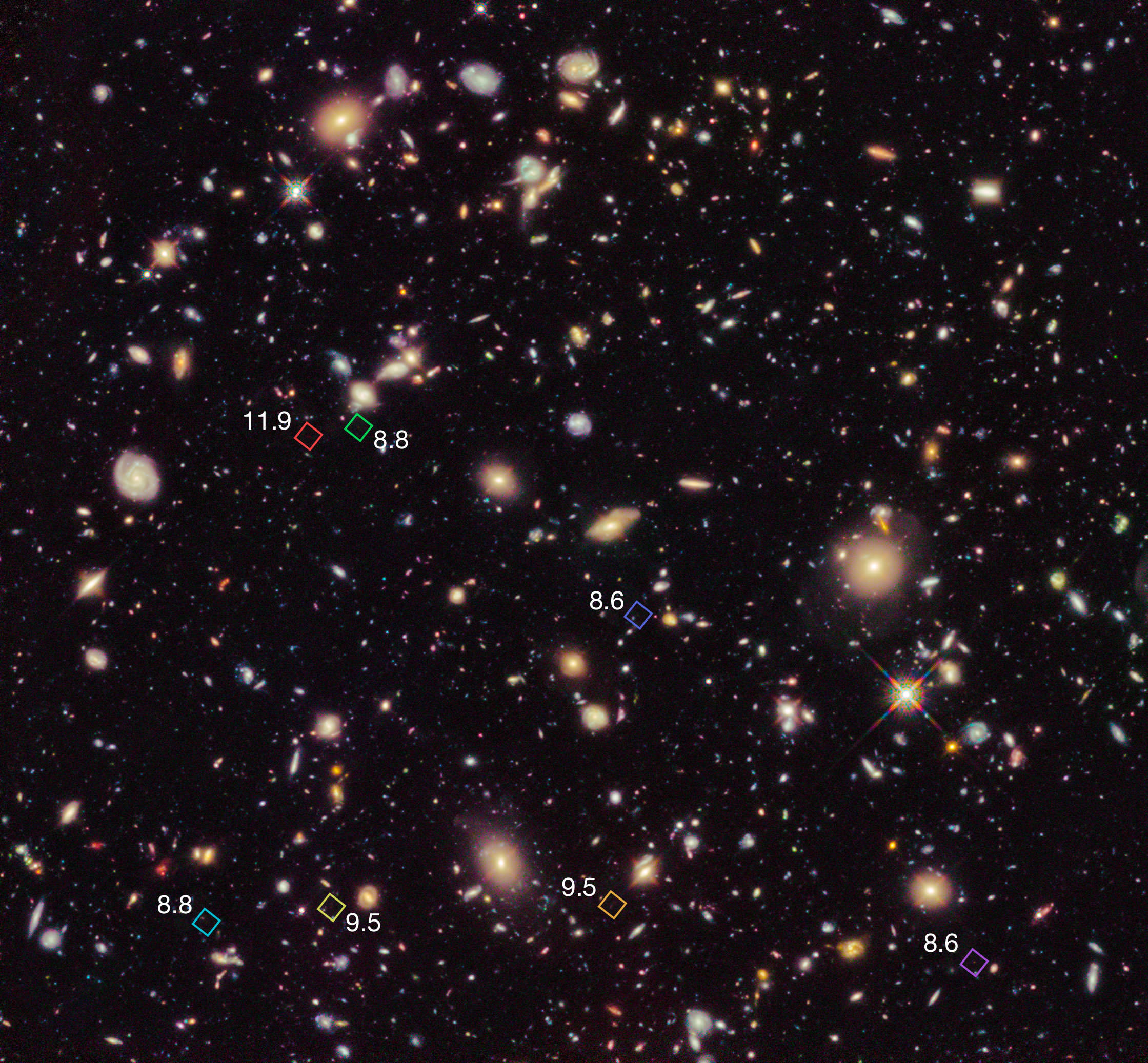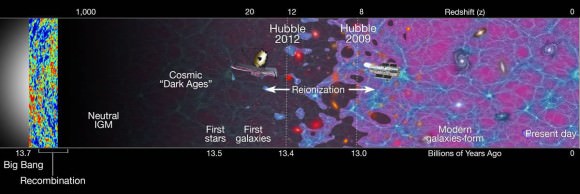This new image of the Hubble Ultra Deep Field (HUDF) 2012 campaign reveals a previously unseen population of seven faraway galaxies, which are observed as they appeared in a period 350 million to 600 million years after the Big Bang. Credit: NASA, ESA, R. Ellis (Caltech), and the UDF 2012 Team
Astronomers using NASA’s Hubble Space Telescope have spotted some of the most distant, dim and ancient galaxies ever detected in a new survey. The images, taken with Hubble’s Wide Field Camera 3 (WFC 3) looks further back in time than any previous Hubble observation, providing information about the conditions in the early Universe.
“This is like a scientific version of the story of Genesis,” said astronomer Avi Loeb from Harvard University.
The seven distant galaxies represent a previously unseen population of galaxies that formed more than 13 billion years ago, when the Universe was less than 3 percent of its present age. In these deepest images to date from Hubble, astronomers were able to take a sample of the amount of galaxies at the time. The results show a smooth decline in the number of galaxies with increasing look-back time to about 450 million years after the Big Bang.
The data provides the first reliable census of this uncharted period of cosmic history, according to the scientists. As astronomers look even deeper into the Universe, galaxy numbers appear to drop off smoothly leading them to believe that the “cosmic dawn” was gradual, not a dramatic event.
“Observations of the microwave afterglow from the Big Bang tell us that reionization happened more than about 13 billion years ago,” said Brant Robertson of the University of Arizona in Tucson, a member of the survey team. “Our data confirms that reionization was a drawn-out process occurring over several hundred million years with galaxies slowly building up their stars and chemical elements. There wasn’t a single dramatic moment when galaxies formed; it was a gradual process.”
These galaxies were found as part of an ambitious Hubble survey of an intensively studied patch of sky known as the Ultra Deep Field (UDF), which was originally taken in 2003-2004, focusing in on a small area in the sky in the constellation Fornax. In the new 2012 campaign, called UDF 2012, a team of astronomers led by Richard Ellis of the California Institute of Technology used the WFC3 to peer deeper into space in near-infrared light than any previous Hubble observation. The observations were made over a period of six weeks during August and September 2012, and the first scientific results are now appearing in a series of scientific papers. The UDF 2012 team is publicly releasing these unique data, after preparing them for other research groups to use.
“Hubble is achieving just great science,” said John Grunsfeld, former astronaut and NASA’s associate administrator for science, speaking at a briefing about the new survey. “This is an origins story, where we’re going back to the beginning, back to the first stars that appeared in the Universe. This validates that when we get James Webb Space Telescope online it will have a lot to look at and a lot to do.”
The James Webb Space Telescope is slated to launch in 2018.
Astronomers detected seven galaxies in the time period 400-600 million years after the Big Bang. All extremely distant, they ranged in distance with redshifts from 8.6 to nearly 12.
Astronomers study the distant universe in near-infrared light because the expansion of space stretches ultraviolet and visible light from galaxies into infrared wavelengths, a phenomenon called “redshift.” The more distant a galaxy, the higher its redshift.
Notably, one of the galaxies may be a distance record breaker, observed 380 million years after the birth of our universe in the Big Bang, corresponding to a redshift of 11.9. This is the galaxy UDFj-39546284, which was previously detected and was originally suggested as the most distant object ever found nearly two years ago by Hubble. Later observations put it at a redshift of 10.3, but the newly refined observations put it even more distant.
A timeline of the Universe and our observations of it. Credit: University of Arizona.
Scientists think that the universe began with the Big Bang about 13.7 billion years ago. Hydrogen formed about 400,000 years later but with no stars, spacetime was dark. About 200 million years later, hydrogen clouds collapsed forming the first stars and galaxies; what astronomers call the “cosmic dawn.” Light from these new stars began breaking down hydrogen into protons and electrons during a time period called cosmic reionization. In the present universe, scientists see galaxies growing in mass and size with the synthesis of elements, leading to the formation of complex molecules including the components to create life. Our Sun and solar system formed just over 4 billion years ago.
“The team pushed Hubble to its limits. This is probably the farthest back Hubble can look, according to the study leader, Richard Ellis. “We are pushing Hubble well beyond what it was designed to do.”
Read more about the findings and the HUDF 2012 Campaign at the HubbleSite.
Read the team’s paper: The Abundance of Star-Forming Galaxies in the Redshift Range 8.5 to 12: New Results from the 2012 Hubble Ultra Deep Field Campaign
Additional Sources: CalTech ESA Hubble




The galaxy at z = 11.9 I compute as being at 350 million light years after the big bang. This galaxy is also on comoving coordinates 32 billion light years away. This is the distance on the Hubble frame and where this galaxy is a modern evolved system such as the Milky Way. I think this is about as far optical observations have taken us.
LC
It may be a case of morning brain but the last graphic and last paragraph are not adding up. The graphic is in billions of years and the description is of first star formation in hundreds of thousands of years? It’s all out of whack. Should you not be speaking of initial star formation in terms of hundreds of millions?
The 400 thousand years refers to the end of the radiation dominated period. This was an earlier epoch when the universe was much denser and space was filled with an ionized gas. This was mostly hydrogen and helium (25%). At the end of this matter formed into neutral atoms and the photons scattered around in that earlier plasma are libertated. If you were to see the universe just after the radiated dominated period the sky would shine with a orange-yellow glow. Now this radiation is redshifted into the microwave spectrum and constitutes the microwave background of the universe.
LC
I was referring to the 200 million years that the image depicts as the beginning of star formation. The article specifies 200,000.
Nice catch, it must be a typo, follow the link under the image to the OH text:
“Cosmic Dawn
• Universe began with Big Bang 13.7 billion years ago
• Hydrogen formed 400,000 yrs later but the Universe
remained Dark
• Hydrogen clouds collapsed 200 million years later
and formed the first stars and galaxies – Cosmic Dawn”
Thanks guys — yep, a typo. Now fixed.
Presumably the Big Bang involved all the matter in the universe, some of which has changed in form, but nothing new has been added. Therefore you can say that we present humans are formed from matter which is 13.7 billion years old. If that is the case then how can light take 13 billion years or so to reach us when we, or our matter, were next door when the light left. The mind boggles. Every bit of the universe was close to every other bit, yet light has taken 13 billion years to get to us. Since light travels at
300000 km per second it should long have passed us by. Help! I’m drowning.
The process that took originally close (aka “causally connected”) volumes and moved them apart, in fact way outside the observable universe, was the inflation of standard cosmology. It is an exponential blowup in scale, so it could do that very easily.
At the end of inflation, which as a thermodynamically adiabatic expansion process supercools spacetime, the spacetime vacuum gets reheated as the potential energy of inflation gets converted into the particles of the observed universe. That can be identified as the “big bang” moment of earlier cosmology, the first time we can observe spacetime with particles and a well defined temperature.
As for expansion vs distances and specifically what can be observed, it gets complicated. I’m sure I’ve seen a non-technical tutorial, but in any case here is a technical tutorial with an illustration that describes the different distancesduring cosmological expansion thoroughly. The figure is taken from “a pedagogical review of inflation“.
” ‘This is like a scientific version of the story of Genesis,’ said astronomer Avi Loeb from Harvard University.” _______________________________________________________________________________
May one suggest that as much Science may be anchored in the biblical Genesis revelation, than in the alternate theoretical one—of HOW the Universe began, written in scientific literature. Could one simple verse be THE “scientific version” of the “Beginning” account? Does the “science” really discount?
Version 1 authoritatively states, “In the beginning…” An Intelligent Agency …
Version 2 confidently declares, In the beginning was the thing, a singularity.
The same Science (stripped of all hypotheticals, which proof does not make) proceeds from either of those to starting points: The furnace appears suddenly, matter is built and processed, smelted(?), and energy formations are “slowly” wrought in Time’s unfolding fabric of Space. (Misconceptions, aside, Version 1 one does NOT constrict time duration, nor manner of execution). “As astronomers look even deeper into the Universe, galaxy numbers appear to drop off smoothly leading them to believe that the ‘cosmic dawn’ was gradual, not a dramatic event.” I take it, this does not diminish the “dramatic” nature of Event Moment of creation (small or large c) – the sudden “Bang” that left the “microwave afterglow”?
Until one version is established—categorically, and thus can be Scientifically announced—absolutely: “THIS is HOW the Universe began …. “, then the alternate version ought to remain a possibility, – unbroken, – and continue to stand. Can it be disproved?
Striving to see and understand First Light: “This is an origins story, where we’re going back to the beginning, …”
A theme struck me: growth! Survey Earth, the Galaxies, and Cosmic Time, and that seems to the central motif, which branches the seed—GROWTH!